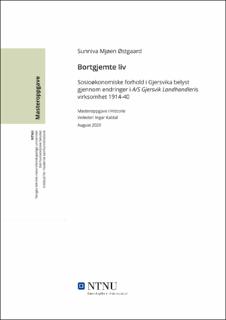| dc.contributor.advisor | Kaldal, Ingar | |
| dc.contributor.author | Østgaard, Sunniva Mjøen | |
| dc.date.accessioned | 2021-09-13T16:05:17Z | |
| dc.date.available | 2021-09-13T16:05:17Z | |
| dc.date.issued | 2020 | |
| dc.identifier | no.ntnu:inspera:59158742:13954288 | |
| dc.identifier.uri | https://hdl.handle.net/11250/2775604 | |
| dc.description.abstract | Denne avhandlingen er en mikrohistorisk analyse av de sosioøkonomiske forholdene i bygda Gjersvika i perioden 1914-40. Forholdene er belyst gjennom en studie av driftsendringer i bygdas nøkkelbedrift, A/S Gjersvika Landhandleri, og hvilken funksjon dens virksomhet hadde i lokalbefolkningens liv. Avhandlingen spør deretter hvorvidt mikrohistorisk metode, gjennom å undersøke et avgrenset spesifikt objekt, kan gi innsikt i større omkringliggende sosioøkonomiske forhold.
Primærkilder for studien er arkivmateriale og muntlige og skriftlige minner. Kildematerialet er analysert og kategorisert som fem driftsendringer som viser utviklingen i landhandelens virksomhet i mellomkrigstiden: Landhandelen blir multiservicesenter; byttehandel som betalingsmetode; endringer i varebeholdningen; utvidet kredittgivning; og bestyreren og hans kones rolle på butikken. Driftsendringene er deretter anvendt som innganger til analyse av den sosioøkonomiske utviklingen i hele bygda.
Studien finner at det i mellomkrigstiden utvikler seg et forhold av gjensidig avhengighet mellom A/S Gjersvik Landhandleri og befolkningen i Gjersvika, som en konsekvens av spesifikke og unike forhold i bygda. Analysen av den mikrohistoriske metodikken avdekker at den ga kontradiktoriske og flertydige beskrivelser av forholdene den undersøkte. Dette muliggjorde avdekking av forhold som ellers ikke ville blitt belyst. Konklusjonen er at dette er en styrke i metoden og en konsekvens av mikrohistoriens fokus på å tolke og forstå kildemateriale på flere måter. | |
| dc.description.abstract | This thesis is a microhistorical analysis of the socio-economic conditions in the village of Gjersvika in the period 1914-40. The conditions are examined through a study of operational changes in the village's keystone business, A/S Gjersvika Landhandleri, and what function its activities had in the lives of the local population. The thesis then asks whether microhistorical methods, by examining a defined specific object, can provide insight into surrounding socio-economic conditions.
Primary sources for the study are archival material and oral and written memoirs. The source material has been analyzed and categorized as five operational changes that show the development of the general store's activities in the interwar period: The general store becomes a multi-service center; barter as a method of payment; changes in store inventory; extended store credit; and the role of the store manager and his wife. These operational changes are then used as inputs for analysis of the socio-economic development in the village as a whole.
The study finds that in the interwar period a relationship of mutual dependence developed between A/S Gjersvik Landhandleri and the population in Gjersvika, as a consequence of specific and unique conditions in the village. The analysis of the microhistorical methodology reveals that it provided contradictory and ambiguous descriptions of the conditions it examined. This made it possible to uncover conditions that would not otherwise have been elucidated. The conclusion finds that this is a strength of the method and a consequence of microhistoric scholarship's focus on interpreting and understanding source material in multiple ways. | |
| dc.language | | |
| dc.publisher | NTNU | |
| dc.title | Bortgjemte liv: Sosioøkonomiske forhold i Gjersvika belyst gjennom endringer i A/S Gjersvik Landhandleris virksomhet 1914-40 | |
| dc.type | Master thesis | |
